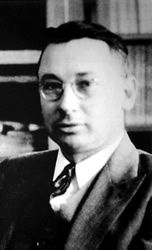

|

|
IN MEMORIAM
William Muriece Hoskins
Professor of Insect Toxicology, Emeritus
UC Berkeley
1896 – 1993
Insect Toxicology started in Berkeley in 1929 with the appointment of William Muriece Hoskins to the University of California faculty and his presentation shortly thereafter of the first course with this title. Bill Hoskins, trained as a chemist, became interested in developing safe and effective methods of pest control and quickly realized the importance of focusing on the insect. He mentored many of the first M.S. and Ph.D. degree candidates in insect toxicology. His philosophy, discoveries, and legacy greatly influenced the field of insect toxicology during the twentieth century.
Bill was a native of California. He entered the University of California, Berkeley, in 1915 and graduated with a degree in mathematics in 1919; one of those four years was spent in the Army in France in World War I. In another three years, he had earned a Ph.D. degree in chemistry from Berkeley. After teaching chemistry for five years at the University of Nevada, he returned to Berkeley as an assistant in biochemistry, then joined the Department of Entomology where he served for 34 years (1929-1963) as professor of insect toxicology. His 128 publications covered inorganic chemistry, insecticide chemistry, the analysis of insecticides, the biochemical basis of insecticide action, and the development of resistance to insecticides. Many of his major scientific breakthroughs came in the early days of organic insecticides, illustrated by a 1945 report on preparing the radioactive dibromo analog of DDT and a 1950 paper in Science, “The detoxification of DDT by resistant houseflies and inhibition of this process by piperonyl cyclonene.” Retirement in 1963 came as a change of environment but not of scientific field, since he became a consultant (with much travel) for the Food and Agriculture Organization of the United Nations and the World Health Organization. During his long and productive career he served as editor of the Journal of Economic Entomology, fellow of the California Academy of Science, a member of Phi Beta Kappa, and for 70 years a member of the Masonic Lodge. Bill Hoskins lived for 97 years, 50 of which he shared with his wife Katherine; they were blessed with many children, grandchildren and great-grandchildren. The year before Bill died, his younger brother Edmond funded the William Muriece Hoskins Chair in Chemical and Molecular Entomology. In this way, the Hoskins family made sure the scientific legacy of Professor Hoskins will continue at Berkeley in perpetuity.
John E. Casida
Credit: “Insect toxicology in the beginning: William Muriece Hoskins,” by John E. Casida. From Journal of Pest Management Science, 57, 2001. Copyright Society of Chemical Industry. Reproduced with permission. Permission is granted by John Wiley & Sons Ltd on behalf of the SCI.